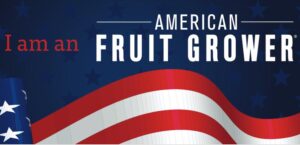How This Farm Operation Is Still Growing Strong With High-Density Peaches
I first met Jon McClarty and Drew Ketelsen in 2018, when they embarked on overhauling the way they grow peaches. McClarty, now 40, and Ketelsen, 38, are President and Vice President, respectively, of HMC Farms, which is no upstart. Located in Kingsburg, CA, they farm 2,500 acres of peaches, plums, nectarines, and grapes. Their neighbors thought they were a little crazy to grow high-density peaches, but the pair was undeterred, saying they thought the way the industry was going, they had no choice. Said McClarty at the time: “We want to push the envelope. We want to be the ones to set an example. If we don’t do anything, it’s almost certain death.”
Very much alive these days, McClarty and Ketelsen are still farming stone fruit, and still going full bore with high-density planting. Of their 2,200 acres of stone fruit, about one-third is now high density, and after next year’s planting they will be close to 1,000 acres. The blocks have been replanted with 670 trees per acre, about five times denser than the industry standard. They are on target to be 100% high density by 2030.
This has been a good year to be a California peach grower, though there haven’t been a lot of those lately. McClarty was right on the mark, though, as the years in between were tough, and some good-sized operations have exited the business. HMC Farms, however, is approaching the future with gusto.
Ketelsen says each year gets more exciting, though a little nerve-wracking, as you have to throw out a lot of knowledge learned on the old system that’s now out of date. But the platforms, especially, have made a huge difference, as they’re finding new opportunities besides harvest, such as thinning and pruning, and their employees love it.
“Top managers who were terrified are now the biggest proponents,” he says. “They’ve done it the old way. They know how hard stone fruit can be, and they’re extremely optimistic about this, which is very fun.”

Jon McClarty (left) and Drew Ketelsen of HMC Farms were featured on the cover of American Fruit Grower in 2018 for high-density stone fruit growing. It’s a whole new way of thinking, and they’re still learning, but most important, they’re thriving. (Photo: David Eddy)
EYES WIDE OPEN
McClarty says they went into high density four years ago knowing there would be a learning curve, and they were right about that. Realizing that, and being flexible and willing to adjust, is critical.
“All varieties are different, and you only get one shot — two weeks (of harvest) a year — to document everything. It will take a while to really understand how we maximize this system,” he says. “Any time you make a change, you know you won’t be best at it from day one. We’re always learning. What’s transferrable? What’s the pattern here?”
When they started, about half their neighboring growers thought they were crazy, and the other half were glad it was HMC that was on the bleeding edge, not them. But during the tough ensuing years, they changed their tune, Ketelsen says.
“The laughing and snickering, that changed by 2020, and now a lot of people think the whole system was planning for this year, 2022, with the $15-an-hour minimum wage. A lot of people were waiting to act, and we wanted to be proactive,” he says. “We’re garnering more curiosity because they are starting to experience what we all know is coming, when labor gets really short.”
MORE PRECOCITY
One key advantage to the high-density system is that the new blocks are more precocious, even more so than they expected when they planted. With standard trees, they get a first, light crop in the third leaf. With these trellised orchards, they expected a light crop in the second leaf, and close to full production in the third. But they are getting more yield in their second leaf than they used to get in the third leaf.
Another advantage they anticipated has also been better than they could have hoped. McClarty says the pickers are buying in — big time. It’s because of the big reduction in physical exertion, climbing on ladders, compared to using platforms. Traditionally, workers would pick 20 fruit at the top of the tree and then move the ladder.
“But this has been a real eye-opening experience. It’s not as exhausting, and they’re more refreshed, and we even pay a higher hourly wage to work on platforms,” he says. “We want to encourage them in using platforms — they’re more productive, so we can pay them more — and they will come work for us if labor is tight.”
Being able to hire employees when neighboring growers are struggling to get enough is a tremendous competitive advantage. The way McClarty and Ketelsen look at it, they’ve earned that advantage by being proactive and refusing to follow the herd.
“There will always be some peach growers,” concludes McClarty, “it might as well be us.”










